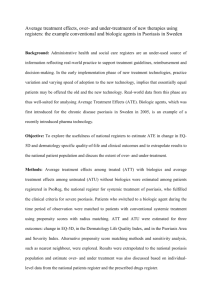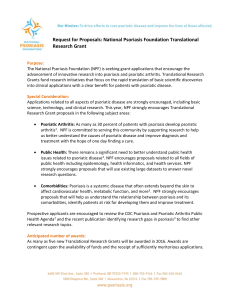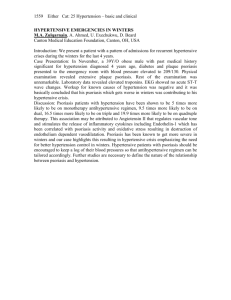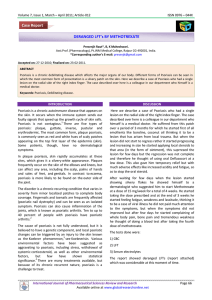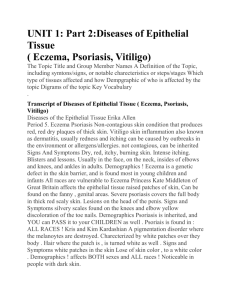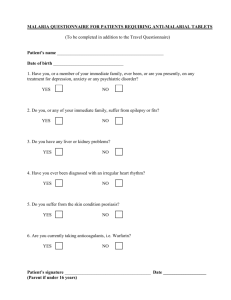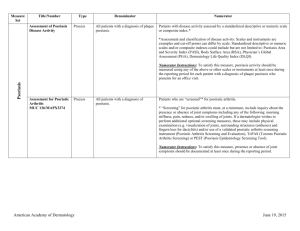Document 13310325
advertisement
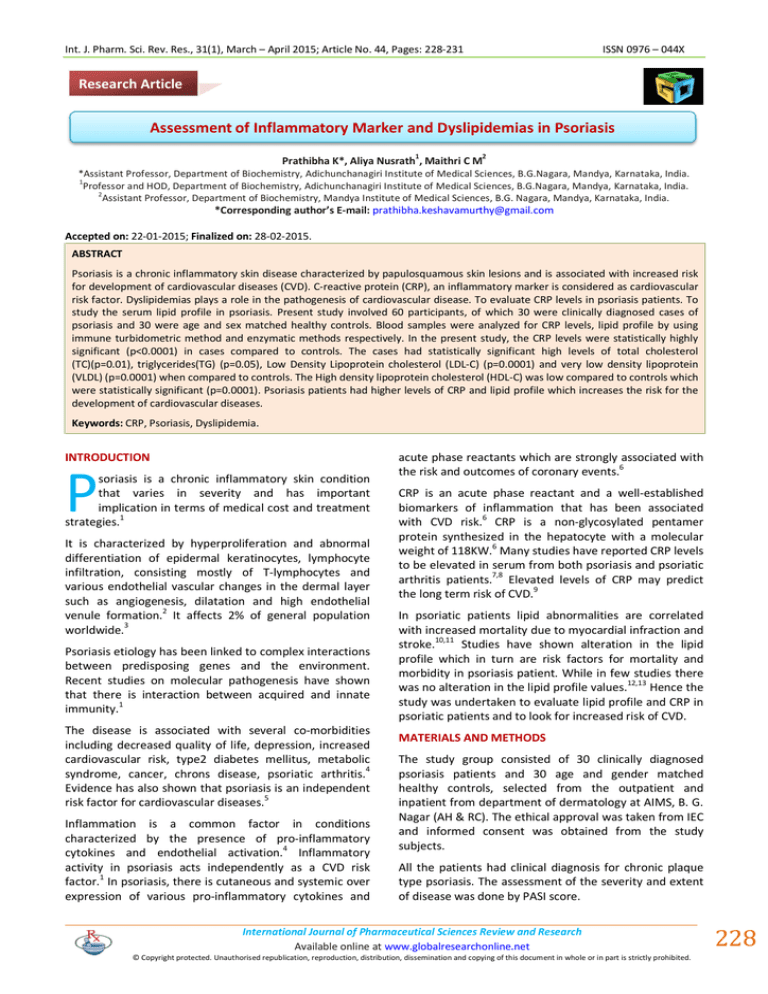
Int. J. Pharm. Sci. Rev. Res., 31(1), March – April 2015; Article No. 44, Pages: 228-231 ISSN 0976 – 044X Research Article Assessment of Inflammatory Marker and Dyslipidemias in Psoriasis 1 2 Prathibha K*, Aliya Nusrath , Maithri C M *Assistant Professor, Department of Biochemistry, Adichunchanagiri Institute of Medical Sciences, B.G.Nagara, Mandya, Karnataka, India. 1 Professor and HOD, Department of Biochemistry, Adichunchanagiri Institute of Medical Sciences, B.G.Nagara, Mandya, Karnataka, India. 2 Assistant Professor, Department of Biochemistry, Mandya Institute of Medical Sciences, B.G. Nagara, Mandya, Karnataka, India. *Corresponding author’s E-mail: prathibha.keshavamurthy@gmail.com Accepted on: 22-01-2015; Finalized on: 28-02-2015. ABSTRACT Psoriasis is a chronic inflammatory skin disease characterized by papulosquamous skin lesions and is associated with increased risk for development of cardiovascular diseases (CVD). C-reactive protein (CRP), an inflammatory marker is considered as cardiovascular risk factor. Dyslipidemias plays a role in the pathogenesis of cardiovascular disease. To evaluate CRP levels in psoriasis patients. To study the serum lipid profile in psoriasis. Present study involved 60 participants, of which 30 were clinically diagnosed cases of psoriasis and 30 were age and sex matched healthy controls. Blood samples were analyzed for CRP levels, lipid profile by using immune turbidometric method and enzymatic methods respectively. In the present study, the CRP levels were statistically highly significant (p<0.0001) in cases compared to controls. The cases had statistically significant high levels of total cholesterol (TC)(p=0.01), triglycerides(TG) (p=0.05), Low Density Lipoprotein cholesterol (LDL-C) (p=0.0001) and very low density lipoprotein (VLDL) (p=0.0001) when compared to controls. The High density lipoprotein cholesterol (HDL-C) was low compared to controls which were statistically significant (p=0.0001). Psoriasis patients had higher levels of CRP and lipid profile which increases the risk for the development of cardiovascular diseases. Keywords: CRP, Psoriasis, Dyslipidemia. INTRODUCTION P soriasis is a chronic inflammatory skin condition that varies in severity and has important implication in terms of medical cost and treatment strategies.1 It is characterized by hyperproliferation and abnormal differentiation of epidermal keratinocytes, lymphocyte infiltration, consisting mostly of T-lymphocytes and various endothelial vascular changes in the dermal layer such as angiogenesis, dilatation and high endothelial venule formation.2 It affects 2% of general population 3 worldwide. Psoriasis etiology has been linked to complex interactions between predisposing genes and the environment. Recent studies on molecular pathogenesis have shown that there is interaction between acquired and innate immunity.1 The disease is associated with several co-morbidities including decreased quality of life, depression, increased cardiovascular risk, type2 diabetes mellitus, metabolic 4 syndrome, cancer, chrons disease, psoriatic arthritis. Evidence has also shown that psoriasis is an independent 5 risk factor for cardiovascular diseases. Inflammation is a common factor in conditions characterized by the presence of pro-inflammatory 4 cytokines and endothelial activation. Inflammatory activity in psoriasis acts independently as a CVD risk factor.1 In psoriasis, there is cutaneous and systemic over expression of various pro-inflammatory cytokines and acute phase reactants which are strongly associated with the risk and outcomes of coronary events.6 CRP is an acute phase reactant and a well-established biomarkers of inflammation that has been associated with CVD risk.6 CRP is a non-glycosylated pentamer protein synthesized in the hepatocyte with a molecular weight of 118KW.6 Many studies have reported CRP levels to be elevated in serum from both psoriasis and psoriatic arthritis patients.7,8 Elevated levels of CRP may predict the long term risk of CVD.9 In psoriatic patients lipid abnormalities are correlated with increased mortality due to myocardial infraction and 10,11 stroke. Studies have shown alteration in the lipid profile which in turn are risk factors for mortality and morbidity in psoriasis patient. While in few studies there 12,13 was no alteration in the lipid profile values. Hence the study was undertaken to evaluate lipid profile and CRP in psoriatic patients and to look for increased risk of CVD. MATERIALS AND METHODS The study group consisted of 30 clinically diagnosed psoriasis patients and 30 age and gender matched healthy controls, selected from the outpatient and inpatient from department of dermatology at AIMS, B. G. Nagar (AH & RC). The ethical approval was taken from IEC and informed consent was obtained from the study subjects. All the patients had clinical diagnosis for chronic plaque type psoriasis. The assessment of the severity and extent of disease was done by PASI score. International Journal of Pharmaceutical Sciences Review and Research Available online at www.globalresearchonline.net © Copyright protected. Unauthorised republication, reproduction, distribution, dissemination and copying of this document in whole or in part is strictly prohibited. 228 © Copyright pro Int. J. Pharm. Sci. Rev. Res., 31(1), March – April 2015; Article No. 44, Pages: 228-231 Inclusion Criteria ISSN 0976 – 044X formula LDL = TC – [HDL + TG/5]. VLDL was calculated by formula, VLDL = TG/5. CRP was measured by immune turbidometric method using turbilyte kit. Patients with psoriasis (both active and inactive disease) who were on only topical treatment were included as study group. Statistical Analysis Exclusion Criteria Statistical analysis was performed using the statistical package: SPSS-16. Students t-test was used to evaluate the differences between the groups. The results were expressed as mean ± SD. p<0.05 was considered statistically significant. Subjects with coexisting inflammatory skin disease, smokers, alcoholics, diabetes mellitus, obesity, history of hyperlipidemia, renal & liver failure, hypothyroidism, lipid lowering drugs for last 3 months prior to blood collection in order to eliminate factors influencing the serum lipid levels and patients on systemic therapy were excluded from the study. RESULTS A total of 60 subjects were investigated of which 30 were clinically diagnosed psoriasis patients taken as cases and another 30 were age and sex matched healthy controls were taken. Of the 30 cases, 20 were males and 10 were females, among controls16 were males and 14 were females (Figure 1). Fasting serum sample was collected using vacutainer under aseptic precaution for determination of lipid profile and CRP. Lipid profile was measured enzymatically by using commercially available standard kits from ERBA and Agappe (Total cholesterol by cholesterol oxidase/peroxidase (CHOD-PAP), Serum TG by GPOTrinder method, end point, HDL by direct method) using autoanalyser EM-200. LDL-C was computed by Friedwalds In the present study psoriatic cases had highly significant CRP levels compared to controls (p=0.0001) (Table 1 and Figure 2). Table 1: Showing CRP values in the study subjects CRP Controls(Mean± SD) mg/dL Cases ( Mean ± SD) mg/dL p value 0.30 ± 0.13 1.23 ± 0.30 0.0001** p < 0.05**=significant Figure 1: Sex Distribution in two Groups Figure 2: Showing CRP values Figure 3: Showing lipid profile parameters in the study subjects Table 2: Showing lipid profile parameters in the study subjects Controls (Mean ± SD)mg/dL Cases (Mean ± SD)mg/dL p value Total Cholesterol 189.67 ± 26.72 212.9 ± 33.5 0.01 Serum Triglycerides 124 ± 26.52 145.67 ± 30.0 0.05** LDL-C 119.83 ± 23.28 151.87 ± 31.95 0.0001** HDL-C 45.03 ± 5.22 31.93 ± 6.917 0.0001** VLDL 24.69 ± 4.95 29.13 ± 7.20 0.0001** p<0.05**= significant International Journal of Pharmaceutical Sciences Review and Research Available online at www.globalresearchonline.net © Copyright protected. Unauthorised republication, reproduction, distribution, dissemination and copying of this document in whole or in part is strictly prohibited. 229 © Copyright pro Int. J. Pharm. Sci. Rev. Res., 31(1), March – April 2015; Article No. 44, Pages: 228-231 Psoriatic patients showed risk changes in lipid profile as shown in Table 2 & Figure 3. There was slight increase in total cholesterol levels in psoriasis when compared to control but this increase was not statistically significant (p=0.01). A significant increase was found in LDL levels (p=0.0001) and triglyceride levels (p=0.05) and VLDL levels (p=0.0001) in psoriatic cases when compared to controls. There was highly significant decrease in HDL levels (p=0.0001) in psoriatic cases compared to controls. DISCUSSION Psoriasis is a common, recurrent proliferative inflammatory skin disease that has been associated with abnormal plasma lipid metabolism and with high frequency of cardiovascular morbidity and mortality.13 This seems to be related to the severity of psoriasis as it occurs more frequently in patients presenting with large areas of body affected with lesions. However, the pathogenesis of atherothrombotic events in psoriasis patient still remains to be recognized. Multiple factors including abnormal lipids and lipoprotein profile and risk factors such as hypertension, obesity and diabetes mellitus have been associated with psoriasis.14 Several reports suggest that psoriatic patients have proatherogenic lipid profile including increased levels of serum triglycerides, LDL-C, VLDL-C, and low HDL-C levels. A study by Rocha P reported increased serum TC, LDL-C, VLDL-C, and low HDL-C levels.15 Piskin in their study has shown serum TC and LDL-C to be significantly higher in psoriasis group than in control group.16 Another study by Dsouza PH13 have found significantly higher levels of serum TC, LDL-C, TG, VLDL-C in psoriatic patients. In the present study, significantly higher levels of serum TG, LDL-C, VLDL-C levels in psoriatic patients was found. An increase in serum TC levels was seen in psoriatic patients but was not statistically significant. A significant decrease in HDL-C was seen in psoriatic patients. Hence these observed changes in the lipid profile values can be considered as modifications of risk for CVD. It has been suggested that abnormal lipid metabolism in psoriasis is associated with high incidence of atherosclerosis. Alteration in lipid profile values i.e. increased triglycerides is associated with changes in procoagulant and prothrombotic factors in the blood.13 Dsouza PH hypothesized that VLDL mediated platelet adhesion play an important role in atherosclerosis. These VLDL remnants are susceptible to retention within the arterial intima there by promotingatherosclerotic plaque growth.17,18 The oxidized LDL is engulfed by activated macrophages which releases TNF α and IL1β. These cytokines causes the inflammation and tissue destruction which is a common theme of chronic inflammatory diseases.19 Inflammation has been implicated in the etiology of atherosclerosis, unstable coronary syndrome and heart ISSN 0976 – 044X failure. Inflammatory immune system activation may lead to increased blood levels of proinflammatory cytokines and acute phase reactants which are strongly associated 20 with risk and outcomes of coronary events. Many studies have demonstrated that increased serum CRP concentrations are positively associated with risk of future coronary events.21 It has been shown that increased levels reflect low grade chronic intimal inflammation rather than direct role of CRP in 22 atherogenic events. In the present study CRP levels was significantly increased in cases compared to controls with p=0.0001. This is in accordance with many other 8,23,24 studies. Several reports have shown that the CRP enhances the expression of local endothelial cell surface adhesion molecules, monocyte chemo attractant protein1, endothelin 1 and endothelial plasminogen activator inhibitor 1. It also reduces endothelial nitric oxide bioactivity, increases the induction of tissue factor in monocytes and LDL uptake by macrophages and co localize with the complement membrane attack complex within atherosclerotic lesions.22 Thus CRP can be used as a biomarker in the identification of cardiovascular risk factor in psoriatic patients. CONCLUSION From the present study we conclude that psoriatic patients are high risk group for cardiovascular diseases due to dyslipidemias and high CRP levels. Early identification using biomarker CRP reduces the mortality and morbidity by initiating treatment. REFERENCES 1. Krueger G, Ellis CN. Psoriasis recent advances in understanding its pathogenesis and treatment. J Am Acad Dermatol, 53, 2005, S 94-100. 2. Jyothi RS, Govindaswamy KS, Gurupadappa K. Psoriasis: An oxidative stress condition. Journal of clinical and diagnostic research, 5(2), 2011 April, 252-253. 3. Guenther LC, Ortonne JP. Pathophysiology of psoriasis: science behind therapy. J Cutan Med Surg, 6, 2002, 2-7. 4. Traub M, Marshall KMS. Psoriasis-pathophysiology, conventional and alternative approaches to treatment. Alternative medicine review, 12(4), 2007, 319-330. 5. Dogan S, Atakan N. Psoriasis: A disease of systemic inflammation with comorbidities. http://dxdoi.org/10.5772.154347) 6. Enerback C. Soluble biomarkers in psoriasis. Eur J Dermatol, 21(6), 2011, 844-850. 7. Chodorowska G, Woinowska D, Juszkiewicz BM. C-reactive protein and alpha 2 macroglobulin plasma activity in medium-severe and severe psoriasis. J Eur Acad Dermatol Venereol, 18, 2004, 180-183. 8. Rocha-pereira P, Santos-silva A, Rebelo L. The inflammatory response in mild and severe psoriasis.Br J Dermatol, 150, 2004, 917-928. International Journal of Pharmaceutical Sciences Review and Research Available online at www.globalresearchonline.net © Copyright protected. Unauthorised republication, reproduction, distribution, dissemination and copying of this document in whole or in part is strictly prohibited. 230 © Copyright pro Int. J. Pharm. Sci. Rev. Res., 31(1), March – April 2015; Article No. 44, Pages: 228-231 9. ISSN 0976 – 044X Koenig W. Predicting risk and treatment benefit in atherosclerosis: the role of C reactive protein. Int J Cardiol, 98, 2005, 199-206. and their relationship with oxidant and antioxidant system in patients with psoriasis. Clin Chim Acta, 328(1-2), 2003, 71-82. 10. Gelfand JM, Neimann AL, Shin DB. Risk of myocardial infarction in patients with psoriasis. JAMA. 296, 2006, 1735-1741. 18. Orem A, Climsit G, Deger O, Vanizor B. The significance of autoantibodies against oxidatively modified LDL in patients with psoriasis. Clin Chim Acta, 284, 1999, 81-88. 11. Neimann AL, Shin DB, Wang X. Prevalence of cardiovascular risk factors in patients with psoriasis. J Am Acad Dermatol, 55, 2006, 829-835. 19. Takeda H, Okuho M, Hoga M, Aizawa K. Lipid Analysis Of Peripheral Blood Monocytes In Psoriatic Patients Using Fourier Transform Infrared Microspectroscopy. J Dermatol, 28, 2001, 303-311. 12. Akhyani M, Ehsani AH, Robati RM, Robati AM. The lipid profile in psoriasis: a controlled study. Journal of the European Academy of dermatology and venereology, 21, 2007, 1330-1332. 13. Dsouza HP, Kuruville M. Dyslipidemia in psoriasis: as a risk for cardiovascular disease. Int J Res Med Sci, 1(2), 2013 may, 52-57. 14. Mallbris L, Granath F, Hamsten A, Stahle M. Psoriasis is associated with lipid at the onset of skin disease. J Am Acad Dermatol, 54, 2006, 614-621. 15. Rocha-pereira P, Santos-Silva A, Rebelo L. Dyslipidemia and oxidative stress in mild and severe psoriasis as a risk for cardiovascular disease. Clinica Chimica Acta, 303, 2001, 3339. 16. Piskin S, Gurkok F, Ekuklu G, Senol M. Serum lipid levels in psoriasis. Yonsei Med J, 44, 2003, 24-26. 17. Vanizor Kural B, Orem A, Climsit Y, Calapoglu M. Evaluation of atherogenic tendency of lipids and lipoprotein content 20. Kremers HM, McEvoy MT, Dann FJ, Gabriel SE. Heart disease in psoriasis. J Am Acad Dermatol, 57, 2007, 347354. 21. Strober B, Teller C, Yamauchi P, Miller JL, Hooper M, Yang YC, Dann F. Effects of etanercept on C-reactive protein levels in psoriasis and psoriatic arthritis. Br J Dermatol. 159(2), 2008 Aug, 322-330. 22. Johnson A M, Amino acid and proteins. In: CA. Burtis, E R. Eshwood, D E. Bruns. Teitz fundamental of clinical chemistry. 6th edi, New Delhi: Elsevier. 2008, 301-303. 23. Isha VKJ and Lal H. C-Reactive Protein and Uric Acid Levels in Patients with Psoriasis Indian J Clin Biochem. 26(3), 2011 July, 309–311. 24. Gerkowitz A, Pietrzk A, Szepietowski JC, Radej S, Chodorowska G. Biochemical marker of psoriasis as a metabolic disease. Folia Histochemista et Cytobiologica, 50(2), 2012, 155-170. Source of Support: Nil, Conflict of Interest: None. International Journal of Pharmaceutical Sciences Review and Research Available online at www.globalresearchonline.net © Copyright protected. Unauthorised republication, reproduction, distribution, dissemination and copying of this document in whole or in part is strictly prohibited. 231 © Copyright pro

